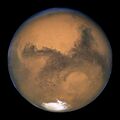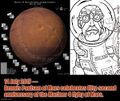Template:Selected anniversaries/July 14: Difference between revisions
Jump to navigation
Jump to search
No edit summary |
No edit summary |
||
| (7 intermediate revisions by the same user not shown) | |||
| Line 1: | Line 1: | ||
<gallery> | <gallery> | ||
|| *** DONE: Pics *** | |||
|| *** Pareidolia: Military Intelligence *** | |||
||1671: Jacques d'Allonville born ... astronomer and mathematician. Pic search: https://www.google.com/search?q=Jacques+d%27Allonville | ||1671: Jacques d'Allonville born ... astronomer and mathematician. Pic search: https://www.google.com/search?q=Jacques+d%27Allonville | ||
| Line 12: | Line 14: | ||
||1865: Benjamin Gompertz dies ... mathematician and statistician. Pic search good: https://www.google.com/search?q=benjamin+gompertz | ||1865: Benjamin Gompertz dies ... mathematician and statistician. Pic search good: https://www.google.com/search?q=benjamin+gompertz | ||
||1868: Gertrude Bell born ... archaeologist and spy. Pic. | |||
||1872: Albert Marque born ... sculptor and doll maker. DOD unknown. Pic: https://commons.wikimedia.org/wiki/File:Albert_Marquet_(1875-1947),_c._1920s.jpg | ||1872: Albert Marque born ... sculptor and doll maker. DOD unknown. Pic: https://commons.wikimedia.org/wiki/File:Albert_Marquet_(1875-1947),_c._1920s.jpg | ||
| Line 21: | Line 25: | ||
||1899: Gregory Breit born ... physicist and academic. During the early stages of the war, Breit was chosen by Arthur Compton to supervise the early design of the first atomic bomb during an early phase in what would later become the Manhattan Project. Breit resigned his position in 1942, feeling that the work was going too slowly and that there had been security breaches on the project; his job went to Robert Oppenheimer, who was later appointed to scientific director of the entire project. Pic. | ||1899: Gregory Breit born ... physicist and academic. During the early stages of the war, Breit was chosen by Arthur Compton to supervise the early design of the first atomic bomb during an early phase in what would later become the Manhattan Project. Breit resigned his position in 1942, feeling that the work was going too slowly and that there had been security breaches on the project; his job went to Robert Oppenheimer, who was later appointed to scientific director of the entire project. Pic. | ||
||1904: | File:Hans_Bernd_Gisevius.jpg|link=Hans Bernd Gisevius (nonfiction)|1904: German diplomat and intelligence officer [[Hans Bernd Gisevius (nonfiction)|Hans Bernd Gisevius]] born. Gisevius will be covert opponent of the Nazi regime, and a radical communist; he will serve as a liaison in Zürich between Allen Dulles, station chief for the American OSS, and the German Resistance forces in Germany. | ||
||1905: Laurence Chisholm Young born ... mathematician known for his contributions to measure theory, the calculus of variations, optimal control theory, and potential theory. Pic. | ||1905: Laurence Chisholm Young born ... mathematician known for his contributions to measure theory, the calculus of variations, optimal control theory, and potential theory. Pic. | ||
| Line 45: | Line 49: | ||
||1948: Harry Brearley dies ... was an English metallurgist, usually credited with the invention of "rustless steel" (later to be called "stainless steel" in the anglophone world). Pic. | ||1948: Harry Brearley dies ... was an English metallurgist, usually credited with the invention of "rustless steel" (later to be called "stainless steel" in the anglophone world). Pic. | ||
||Richard Edler von Mises | ||1953: Richard Edler von Mises dies ... scientist and mathematician who worked on solid mechanics, fluid mechanics, aerodynamics, aeronautics, statistics and probability theory. Pic. | ||
||1954: Thomas Wolff born ... mathematician, working primarily in the fields of harmonic analysis, complex analysis, and partial differential equations. Pic. | |||
File:Small Boy nuclear test 1962.jpg|link=Small Boy (nuclear test) (nonfiction)|1962: United States Army tests [[Small Boy (nuclear test) (nonfiction)|Small Boy, a tactical nuclear weapon]], at the Nevada Test Site. Yield was 1.65 kt. | File:Small Boy nuclear test 1962.jpg|link=Small Boy (nuclear test) (nonfiction)|1962: United States Army tests [[Small Boy (nuclear test) (nonfiction)|Small Boy, a tactical nuclear weapon]], at the Nevada Test Site. Yield was 1.65 kt. | ||
File:Mars 23 aug 2003 hubble.jpg|link=Mars (nonfiction)|1965: The Mariner 4 flyby of [[Mars (nonfiction)|Mars]] takes the first close-up photos of another planet. | File:Mars 23 aug 2003 hubble.jpg|link=Mars (nonfiction)|1965: The Mariner 4 flyby of [[Mars (nonfiction)|Mars]] takes the first close-up photos of another planet. | ||
| Line 60: | Line 60: | ||
||1992: 386BSD is released by Lynne Jolitz and William Jolitz beginning the Open Source operating system revolution. Linus Torvalds releases his Linux soon afterwards. | ||1992: 386BSD is released by Lynne Jolitz and William Jolitz beginning the Open Source operating system revolution. Linus Torvalds releases his Linux soon afterwards. | ||
||1996: Kenneth Tompkins Bainbridge dies ... physicist at Harvard University who did work on cyclotron research. His precise measurements of mass differences between nuclear isotopes allowed him to confirm Albert Einstein's mass-energy equivalence concept. He was the Director of the Manhattan Project's Trinity nuclear test, which took place July 16, 1945. Bainbridge described the Trinity explosion as a "foul and awesome display". He remarked to J. Robert Oppenheimer immediately after the test, "Now we are all sons of bitches." Pic. | ||1996: Kenneth Tompkins Bainbridge dies ... physicist at Harvard University who did work on cyclotron research. His precise measurements of mass differences between nuclear isotopes allowed him to confirm Albert Einstein's mass-energy equivalence concept. He was the Director of the Manhattan Project's Trinity nuclear test, which took place July 16, 1945. Bainbridge described the Trinity explosion as a "foul and awesome display". He remarked to J. Robert Oppenheimer immediately after the test, "Now we are all sons of bitches." Pic. | ||
| Line 67: | Line 65: | ||
||2000: Sir Marcus Laurence Elwin "Mark" Oliphant dies ... physicist and humanitarian who played an important role in the first experimental demonstration of nuclear fusion and also the development of nuclear weapons. Pic. | ||2000: Sir Marcus Laurence Elwin "Mark" Oliphant dies ... physicist and humanitarian who played an important role in the first experimental demonstration of nuclear fusion and also the development of nuclear weapons. Pic. | ||
||2015: NASA's New Horizons probe performs the first flyby of Pluto, and thus completes the initial survey of the Solar System. | ||2015: NASA's ''New Horizons'' probe performs the first flyby of Pluto, and thus completes the initial survey of the Solar System. | ||
||2017: Maryam Mirzakhani dies ... mathematician and a professor of mathematics at Stanford University. Her research topics included Teichmüller theory, hyperbolic geometry, ergodic theory, and symplectic geometry. Pic. | ||2017: Maryam Mirzakhani dies ... mathematician and a professor of mathematics at Stanford University. Her research topics included Teichmüller theory, hyperbolic geometry, ergodic theory, and symplectic geometry. Pic. | ||
File: | File:Dennis Paulson of Mars (14 July 2017).jpg|link=Dennis Paulson of Mars|2017: ''[[Dennis Paulson of Mars]]'' celebrates fifty-second anniversary of the Mariner 4 flyby of Mars. | ||
</gallery> | </gallery> | ||
Latest revision as of 10:09, 7 February 2022
1856: Mathematician Charles Hermite is elected to fill the vacancy created by the death of Jacques Binet in the Académie des Sciences.
1904: German diplomat and intelligence officer Hans Bernd Gisevius born. Gisevius will be covert opponent of the Nazi regime, and a radical communist; he will serve as a liaison in Zürich between Allen Dulles, station chief for the American OSS, and the German Resistance forces in Germany.
1962: United States Army tests Small Boy, a tactical nuclear weapon, at the Nevada Test Site. Yield was 1.65 kt.
1965: The Mariner 4 flyby of Mars takes the first close-up photos of another planet.
2017: Dennis Paulson of Mars celebrates fifty-second anniversary of the Mariner 4 flyby of Mars.




